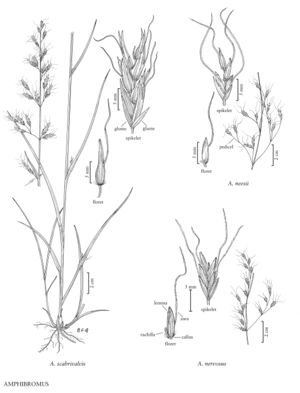Amphibromus nervosus
Plants perennial; usually cespitose, occasionally rhizomatous. Culms 30-125 cm tall, 1-3 mm thick, erect, terete to flattened, glabrous; nodes 2-5; lowest internodes not swollen. Sheaths smooth or scabridulous, ribbed; ligules 10-20 mm, acute to acuminate; blades 10-30 cm long, 1.5-3.5 mm wide, flat or involute, smooth to scabrous, abaxial surfaces scabridulous, adaxial surfaces deeply ribbed, scabrous. Terminal panicles 15-40 cm, erect, sparse, the lower portion sometimes partially enclosed in the uppermost sheaths; branches usually 7-15 cm, ascending or appressed, often flexuous; pedicels usually 10-20 mm. Spikelets 10-16 mm, with 4-6 florets. Glumes unequal to subequal, green, sometimes purplish in the center, with hyaline margins; lower glumes 2.5-5.5 mm, 3-5-veined; upper glumes 3-6.5 mm, 3-5-veined; lemmas 5-7.2 mm, 5-7-veined, scabrous, apices not appearing constricted, usually 4-toothed, 2 lateral teeth smaller than the 2 central teeth, awned from the lower 2/5 – 3/5 of the lemmas, awns 12-22 mm, geniculate and twisted; paleas 3/4 as long as to subequal to the lemmas, papillose; anthers of chasmogamous florets 2.2-3 mm, those of cleistogamous florets 0.3-1.4 mm. 2n = unknown.
Discussion
Amphibromus nervosus is the most common species in the genus. It has frequently been misidentified as A. neesii, but has a lower awn insertion. Such misidentification is the basis of the report of A. neesii in North America; examination of the voucher specimens showed them to be A. nervosus. They were collected in 1990 from a vernal pool in Sacramento County, California. Its seeds had been found earlier as a contaminant in Trifolium subterraneum seed being imported from Australia. The discovery of living plants is of particular concern, because of their ability to invade and survive in vernal pools.
Selected References
None.
Lower Taxa
"decumbent" is not a number.
